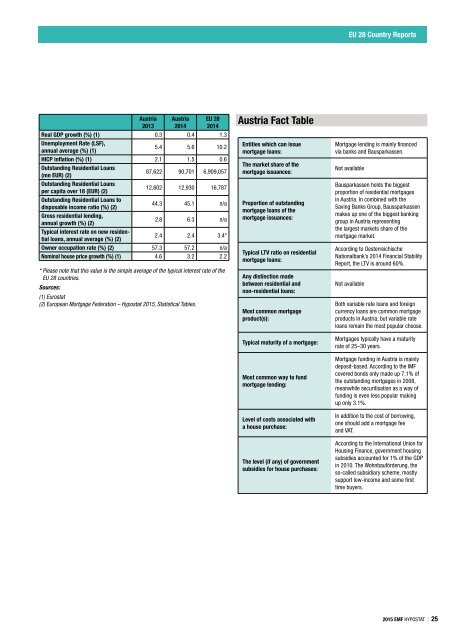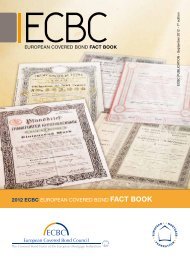Hypostat 2015
On 30 September 2015, the EMF-ECBC published Hypostat 2015 , which is its main statistical report, encompassing data on recent developments in housing and mortgage markets in the EU28 and beyond. Hypostat is the result of a collaborative effort by the European Mortgage Federation’s national delegations and external experts. The publication covers 33 countries – i.e. the EU28 plus Iceland, Norway, Russia, Turkey and the United States.
On 30 September 2015, the EMF-ECBC published Hypostat 2015 , which is its main statistical report, encompassing data on recent developments in housing and mortgage markets in the EU28 and beyond. Hypostat is the result of a collaborative effort by the European Mortgage Federation’s national delegations and external experts.
The publication covers 33 countries – i.e. the EU28 plus Iceland, Norway, Russia, Turkey and the United States.
Create successful ePaper yourself
Turn your PDF publications into a flip-book with our unique Google optimized e-Paper software.
EU 28 Country Reports<br />
Austria<br />
2013<br />
Austria<br />
2014<br />
EU 28<br />
2014<br />
Real GDP growth (%) (1) 0.3 0.4 1.3<br />
Unemployment Rate (LSF),<br />
annual average (%) (1)<br />
5.4 5.6 10.2<br />
HICP inflation (%) (1) 2.1 1.5 0.6<br />
Outstanding Residential Loans<br />
(mn EUR) (2)<br />
87,622 90,701 6,909,057<br />
Outstanding Residential Loans<br />
per capita over 18 (EUR) (2)<br />
12,602 12,930 16,787<br />
Outstanding Residential Loans to<br />
disposable income ratio (%) (2)<br />
44.3 45.1 n/a<br />
Gross residential lending,<br />
annual growth (%) (2)<br />
2.8 6.3 n/a<br />
Typical interest rate on new residential<br />
loans, annual average (%) (2)<br />
2.4 2.4 3.4*<br />
Owner occupation rate (%) (2) 57.3 57.2 n/a<br />
Nominal house price growth (%) (1) 4.6 3.2 2.2<br />
* Please note that this value is the simple average of the typical interest rate of the<br />
EU 28 countries.<br />
Sources:<br />
(1) Eurostat<br />
(2) European Mortgage Federation – <strong>Hypostat</strong> <strong>2015</strong>, Statistical Tables.<br />
Austria Fact Table<br />
Entities which can issue<br />
mortgage loans:<br />
The market share of the<br />
mortgage issuances:<br />
Proportion of outstanding<br />
mortgage loans of the<br />
mortgage issuances:<br />
Typical LTV ratio on residential<br />
mortgage loans:<br />
Any distinction made<br />
between residential and<br />
non‐residential loans:<br />
Most common mortgage<br />
product(s):<br />
Typical maturity of a mortgage:<br />
Most common way to fund<br />
mortgage lending:<br />
Level of costs associated with<br />
a house purchase:<br />
The level (if any) of government<br />
subsidies for house purchases:<br />
Mortgage lending is mainly financed<br />
via banks and Bausparkassen.<br />
Not available<br />
Bausparkassen holds the biggest<br />
proportion of residential mortgages<br />
in Austria. In combined with the<br />
Saving Banks Group, Baussparkassen<br />
makes up one of the biggest banking<br />
group in Austria representing<br />
the largest markets share of the<br />
mortgage market.<br />
According to Oesterreichische<br />
Nationalbank’s 2014 Financial Stability<br />
Report, the LTV is around 60%.<br />
Not available<br />
Both variable rate loans and foreign<br />
currency loans are common mortgage<br />
products in Austria, but variable rate<br />
loans remain the most popular choose.<br />
Mortgages typically have a maturity<br />
rate of 25–30 years.<br />
Mortgage funding in Austria is mainly<br />
deposit-based. According to the IMF<br />
covered bonds only made up 7.1% of<br />
the outstanding mortgages in 2008,<br />
meanwhile securitisation as a way of<br />
funding is even less popular making<br />
up only 3.1%.<br />
In addition to the cost of borrowing,<br />
one should add a mortgage fee<br />
and VAT.<br />
According to the International Union for<br />
Housing Finance, government housing<br />
subsidies accounted for 1% of the GDP<br />
in 2010. The Wohnbauförderung, the<br />
so-called subsidiary scheme, mostly<br />
support low-income and some first<br />
time buyers.<br />
<strong>2015</strong> EMF HYPOSTAT | 25



